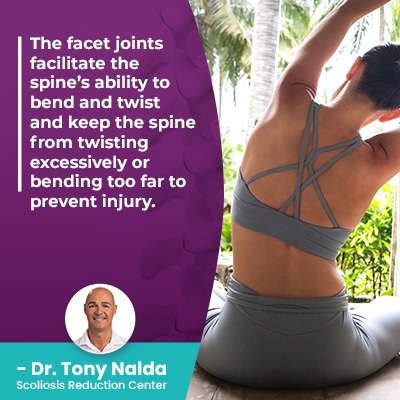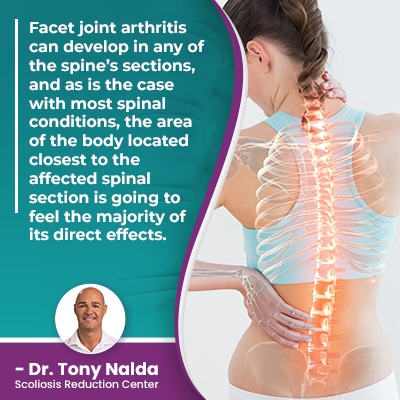Facet Joint Arthritis: Diagnosis, Symptoms, and Treatment

The spine’s design is based on movement, and this is achieved through the combined effort of different spinal structures, including the facet joints. Spinal segments consist of two adjacent vertebrae, an intervertebral disc in between, and a pair of facet joints; together they give the spine structure and flexibility, and the health of each segment is dependent on the health of its individual parts.
The spine consists of many moveable parts, and the facet joints connect the bones of the spine (vertebrae) and help keep the spine stable, while facilitating flexible movement. Facet joint arthritis involves the loss of cartilage covering the joint ends.
Table of Contents
Anatomy of a Healthy Spine
In a healthy spine, its vertebrae are stacked on top of one another in a straight, neutral, and natural alignment.
If the vertebrae are in place, the spine’s natural and healthy curves are also in place, and this helps the spine to function as designed.
There are three main spinal sections: the cervical spine (neck), thoracic spine (middle/upper back), and the lumbar spine (lower back).
Each spinal section consists of vertebrae, and as mentioned, adjacent vertebrae are separated by an intervertebral disc that provides cushioning to prevent friction, gives the spine with structure, enables flexible movement, and acts as the spine’s shock absorbers.
What are Facet Joints?
The vertebrae are connected by facet joints, and the roots of 31 pairs of spinal nerves pass through the joints to traverse from the spinal cord into the different areas of the body (arms, legs, etc).
 The facet joints facilitate the spine’s ability to bend and twist and keep the spine from twisting excessively or bending too far to prevent injury.
The facet joints facilitate the spine’s ability to bend and twist and keep the spine from twisting excessively or bending too far to prevent injury.
The facet joints combine forces with the disc in each motion segment to help distribute loads and regulate movement.
While the spine’s design is based on movement, excessive movement of a vertebra or a segment can become problematic.
What is Facet Joint Arthritis?
There is a natural degree of spinal degeneration expected with age, and facet joint arthritis develops gradually over time as the spine’s individual parts start to deteriorate.
While age-related degeneration will happen to everyone at some point, there are certain lifestyle choices that can either increase or decrease the rate of spinal degeneration.
The cumulative effect of carrying excess weight, leading a sedentary lifestyle, chronic poor posture, and repeatedly lifting heavy objects incorrectly can make the spine particularly vulnerable to spinal degeneration and arthritic changes; this is because these lifestyle choices expose the spine to uneven wear and pressure.
There are many different types of arthritis that can affect any area of the body, and the most prevalent are rheumatoid arthritis and osteoarthritis.
Rheumatoid arthritis is an autoimmune disease that involves a person's immune system attacking the facet joint linings, causing inflammation and weakness; osteoarthritis involves the cartilage that surrounds the ends of the facet joints breaking down and eroding over time.
If one or more of the facet joints in the spine develops arthritis, the weakness and inflammation disrupts the stability of the parts they are attached to: adjacent vertebrae and the intervertebral disc in between.
When inflammation develops in a facet joint, it also affects its surroundings by pushing into the spaces around and within the spine, and this can cause nerve compression, which irritates nerve endings and can cause a number of symptoms felt throughout the body.
What are the Symptoms of Facet Joint Arthritis?
Each case of facet joint arthritis is unique and will produce its own unique symptoms and level of symptom severity.
In most cases, the main symptom of facet joint arthritis is pain felt around the affected facet joint and in other areas of the body, depending on the degree of nerve involvement.
 Facet joint arthritis can develop in any of the spine’s sections, and as is the case with most spinal conditions, the area of the body located closest to the affected spinal section is going to feel the majority of its direct effects.
Facet joint arthritis can develop in any of the spine’s sections, and as is the case with most spinal conditions, the area of the body located closest to the affected spinal section is going to feel the majority of its direct effects.
For example, those diagnosed with cervical facet joint arthritis have developed it in the neck, and this commonly involves pain that radiates into the back of the head, the ears, and the shoulders; pain from facet joint arthritis in the lumbar spine commonly includes pain in the lower back and pain that radiates into the buttocks, hips, and/or thighs.
Sciatic nerve pain can be caused by lumbar facet joint arthritis as the sciatic nerve starts in the lumbar spine, and if an affected facet joint and its surroundings has become inflamed and is pushing on the sciatic nerve, sciatica can develop as a related complication.
Certain types of movement can become difficult for people with facet joint arthritis, and particularly after long periods without movement, such as during sleep or sitting for extended periods of time, can make it challenging to stand upright and vertically extend the spine.
As the joints are eroding and degenerating, joint stiffness can contribute to a loss of spinal flexibility and range of motion in the affected area of the spine, and this can make bending, lifting, and twisting motions difficult.
When the spine can’t twist properly, a person tends to compensate by twisting their entire bodies, as the spine’s ability to enable a smooth and controlled twisting motion is limited.
People are most vulnerable to developing facet joint arthritis as they age, if they have sustained a spinal injury/trauma, have degenerative disc disease (DDD), are genetically predisposed, and/or have chronic poor posture.
So now that we have defined the condition and explored some of its common symptoms, let’s talk about treatment options.
Treatment Options for Facet Joint Arthritis
Being diagnosed with facet joint arthritis commonly involves a physical examination that includes taking the patient’s family and medical history, with a focus on arthritis and/or spinal conditions within the family, and an X-ray to see what’s happening in and around the spine.
Here at the Scoliosis Reduction Center, I apply a conservative treatment approach that’s non-invasive and integrates a number of treatment modalities for the best results.
First of all, treatment plans need to be customized to address key patient/condition variables such as the underlying cause of the arthritis, severity, and experienced symptoms.
When it comes to addressing inflammation and swelling, the goal is to relax muscles, relieve pain, and improve circulation in the area, and alternating hot/cold therapy can help achieve these things.
When lifestyle factors are contributing to uneven forces and pressure on the spine, lifestyle guidance is an important facet of treatment; this can involve weight management, postural remodeling, education on the ergonomics of heavy lifting, and integrating condition-specific therapeutic exercises through physical therapy.
Improving lifestyle factors that are influencing spinal health can help create an environment inside the body that’s conducive to healing and is going to be more responsive to treatment.
Physical therapy can help by applying condition-specific exercises that can help with spinal strength, and keeping the spine’s surrounding muscles strong and loose means the spine is optimally supported and stabilized; this means there is less pressure on the spine and its individual parts, like the facet joints.
In certain cases, a corrective brace can help by providing spinal support and stabilization for pain relief during the intense phase of treatment, but this isn’t a common type of joint arthritis treatment.
While condition-specific chiropractic care can’t restore a loss of cartilage, it can work towards realigning the spine by manually adjusting the position of the affected vertebral bodies, and this takes pressure off the joint’s surroundings, such as the spinal nerves.
When degenerative disc disease has contributed to the development of facet joint arthritis, chiropractic care can also help improve disc health by repositioning vertebrae that are applying uneven pressure to the disc in between, and increasing circulation in the area can improve disc health, nutrition, hydration, and restoration.
The main goal of facet joint arthritis treatment is to improve spinal alignment, prevent further deterioration, manage pain, and improve a patient’s overall quality of life.
Conclusion
The spine performs many important roles in maintaining health and wellness; it helps us stand upright, practice good posture, bend, twist, lift, and it works in tandem with the brain to form the body’s central nervous system (CNS).
Considering the many important roles of the spine, it’s understandable that it’s vulnerable to developing a number of conditions/issues.
When the joints of the spine start to degenerate and experience a loss of cartilage, this affects the ability of the joints to perform their roles: giving the spine structure, facilitating flexibility, and preventing the spine from twisting beyond a healthy level and/or bending too far forward.
If the individual motion segments of the spine are not moving as they should, this affects its surroundings by introducing uneven wear and pressure to the section and its surrounding muscles and nerves.
While there are never treatment guarantees, when addressed proactively, the symptoms of facet joint arthritis can be reduced by improving the health of the spinal segment affected, addressing its underlying cause, and customizing a treatment plan around it.
Dr. Tony Nalda
DOCTOR OF CHIROPRACTIC
After receiving an undergraduate degree in psychology and his Doctorate of Chiropractic from Life University, Dr. Nalda settled in Celebration, Florida and proceeded to build one of Central Florida’s most successful chiropractic clinics.
His experience with patients suffering from scoliosis, and the confusion and frustration they faced, led him to seek a specialty in scoliosis care. In 2006 he completed his Intensive Care Certification from CLEAR Institute, a leading scoliosis educational and certification center.
About Dr. Tony Nalda
 Ready to explore scoliosis treatment? Contact Us Now
Ready to explore scoliosis treatment? Contact Us Now





